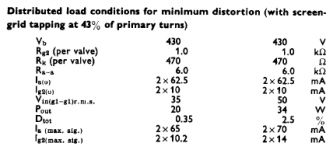hi all, i've built my first tube amp, with 2x EL34s per channel class AB , driving ultralinear opts.
it's a cathode bias, fairly simple to measure bias, but since i'm a noob at this, i'd like confirmation that i'm doing things right:
bias resistor (from cathode to common + bypass cap) is 500ohm (2x 1k in parallel)--- 1 resistor for both tubes.
voltage drop across the cathode resistor is ~36v, which means ~34mA plate current for each tube (subtracted ~1,5mA for the screen)
i got ~404v plate-to-cathode (440v-36v), which brings it at ~13.7w plate dissipation @ idle. that's normal to cool, if i have understood things right, please confirm.
thanx for your time
it's a cathode bias, fairly simple to measure bias, but since i'm a noob at this, i'd like confirmation that i'm doing things right:
bias resistor (from cathode to common + bypass cap) is 500ohm (2x 1k in parallel)--- 1 resistor for both tubes.
voltage drop across the cathode resistor is ~36v, which means ~34mA plate current for each tube (subtracted ~1,5mA for the screen)
i got ~404v plate-to-cathode (440v-36v), which brings it at ~13.7w plate dissipation @ idle. that's normal to cool, if i have understood things right, please confirm.
thanx for your time
thank you gentlemen.
i'll consider using 470ohm cathode resistor, it doesn't seem it needs it tho, it has a big, effortless sound as it is already.
i don't mind some more tube life too.
thanx again
p.s. these things are highly addictive, after i'm finished with this, i'll try some class A
i'll consider using 470ohm cathode resistor, it doesn't seem it needs it tho, it has a big, effortless sound as it is already.
i don't mind some more tube life too.
thanx again
p.s. these things are highly addictive, after i'm finished with this, i'll try some class A
...1 resistor for both tubes.
Shared cathode resistor is not optimal. It increases the out-of-balance (DC) between tubes. It is acceptable if perfectly matched tubes are used.
The amount of idle current has massive impact to the THD that output tubes generate.
How cool or warm the tubes operate is a minor detail if hifi is to be achieved.
Shared cathode resistor is not optimal...
yes, i can easily change it to 1 resistor per tube, make the bias a bit hotter too, thanx
- Status
- This old topic is closed. If you want to reopen this topic, contact a moderator using the "Report Post" button.
- Home
- Amplifiers
- Tubes / Valves
- Please check my biasing numbers/methodology (EL34)
